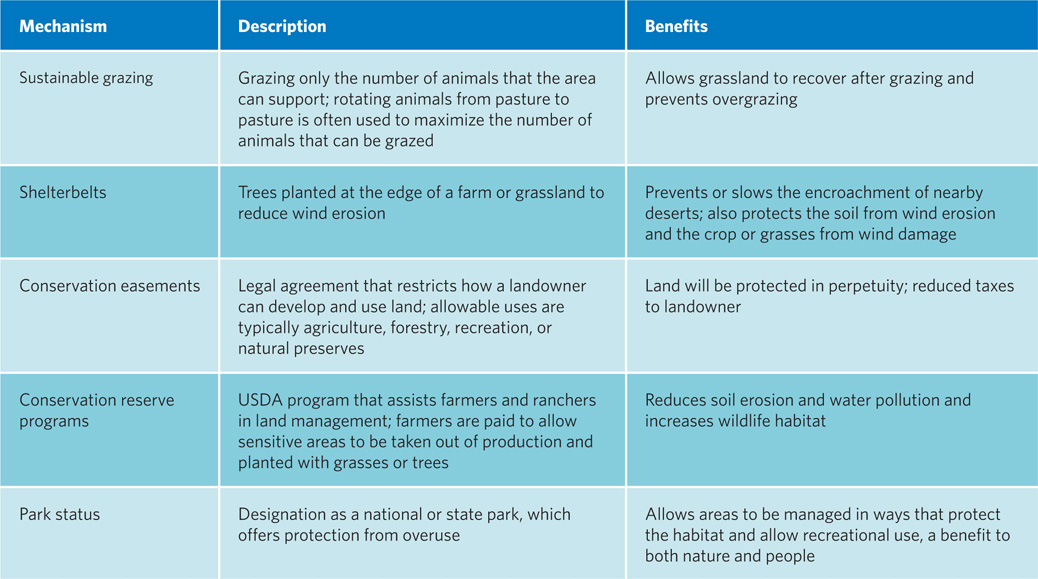Grassland protection takes many forms.
KEY CONCEPT 27.7
Grasslands can be protected by using sustainable grazing techniques, employing steps to prevent soil erosion, or giving grasslands protected status.
Grasslands are not just here for human use, and anything we can do to restore or protect them will benefit us and other species as well. Ranchers and scientists are showing that improved grazing techniques can help protect and even restore some degraded grasslands. Another land-management technique that also reduces soil erosion and protects grasslands from degradation is the planting of shelterbelts—a stand of trees that blocks the wind and thus decreases wind erosion. Shelterbelt programs helped the United States recover from the Dust Bowl and are being used today in areas facing desertification, such as Inner Mongolia and China (where the shelterbelt is referred to as the “Green Wall of China”). Other approaches, such as conservation easements, reserves, and protected parks, also help protect grasslands by limiting land uses and making it easier to keep the land in some level of protected status. TABLE 27.1


Which of the methods described in TABLE 27.1 allow a landowner to continue to use his or her land for agriculture or ranching, and which take the land completely out of commercial production?
Sustainable grazing and the use of shelterbelts allow land to continue to be used as ranch or farmland. Conservation easements put some restrictions on the way land is to be used but still allows many agricultural uses. Conservation reserve programs or assigning park status to land prevents heavy agricultural use such as crop agriculture and ranching.
Nevertheless, a growing number of U.S. ranchers are following Howell’s and Savory’s lead. Success in Zimbabwe has been followed by successes in California, Texas, Colorado, and New Mexico. “Change is tough,” says Joe Morris, a rancher in central California who has been using Savory’s methods with great success. “Ranching is a culture, steeped in tradition. But our lands are hurting and our communities are dying, and we know we’ve got to do something to fix that.”
Only a year into the new grazing method, Howell and his partners ran 2,300 yearling cattle out of Horse Creek Ranch—a nearly 100% increase from years past and a number they hope to double next season. “It’s going to be a long road,” says Howell. “But we’ve already made so much progress, in just one season.” Meanwhile, back on the range, tiny buds of grass have begun to poke up everywhere.
Select References:
Bailey, D. W., et al. (1996). Mechanisms that result in large herbivore grazing distribution patterns. Journal of Range Management, 49(5): 386–400.
Briske, D. D., et al. (2013). The Savory method can not green deserts or reverse climate change: A response to the Allan Savory TED video. Rangelands, 35(5): 72–74.
Briske, D. D., et al. (2011). Origin, persistence, and resolution of the rotational grazing debate: Integrating human dimensions into rangeland research. Rangeland Ecology and Management, 64(4): 325–334.
Heitschmidt, R. K., et al. (2005). Interactive effects of drought and grazing on Northern Great Plains rangelands. Rangeland Ecology and Management, 58(1): 11–19.
Molinar, J., et al. (2002). Short duration grazing research in Africa. Rangelands Archives, 24(4): 9–12.
Savory, A., & S. Parsons. (1980). The Savory grazing method. Rangelands, 2(6): 234–237.
Teague, R., et al. (2013). Multi-paddock grazing on rangelands: Why the perceptual dichotomy between research results and rancher experience? Journal of Environmental Management, 128: 699–717.
PERSONAL CHOICES THAT HELP
Because of overgrazing and rampant soil erosion, the grasslands have lost a larger proportion of their habitat than the tropical rain forests. But most people have never worried about preserving the grasslands—or are even aware of how little remains (only about 1–2%). Grassland habitats provide many ecosystem services: They capture CO2 and are home to an immense range of biodiversity. They can be used for both economic growth as well as recreation, but only if they are managed properly.
Individual Steps
•Visit a remnant or restored prairie. Such prairie preserves are scattered throughout the heart of North America, ranging from the Canadian provinces of Alberta, Saskatchewan, and Manitoba in the north, down through the Great Plains to southern Texas and Mexico, and from the Rocky Mountains eastward to western Indiana. There are more than 20 national grasslands and several dozen more state and local prairie preserves.
•Explore the difference between turf grass and native grasses. Find out what grasses are native to your area and plant some in your yard.
•Purchase grass-fed beef or free-range bison meat as a way to support sustainable use of grassland ecosystems.
Group Action
•If there are prairie restoration efforts under way in your community—such as seeding, brush cutting, removal of invasive species, and seed collecting—participate in these efforts.
Policy Change
•Research national legislation designed to protect and restore native habitats like grasslands and write a letter to your state representative asking him or her to vote for the legislation.
•Organize a fundraiser and donate the proceeds to research that examines the pros and cons of using grasslands for either biomass production or wind farms.